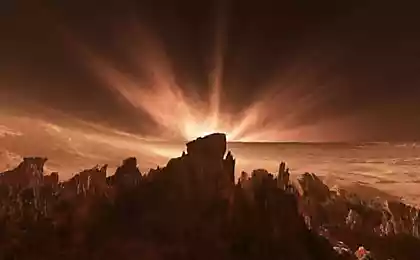719
Five extraordinary ideas NASA
In addition to the development of current projects, NASA does not forget about the future, investing in technology and ideas that, at first glance, appear as a purely фантастика. However, some of them may possibly form the basis for a new generation of space projects. For example, a hundred years ago, the idea of landing on the moon was considered absurd, but after half a century it has been implemented. Recently NASA identified five concept ideas that plans to develop and study with long-term view to sell. Apparently, very distant.
The program is innovative advanced concept ideas (Innovative Advanced Concepts Program) NASA, - NIAC, - this division dedicated search, analysis and selection of promising ideas generated by researchers, universities, and even independent companies. Selected projects in the future may receive support from NASA, which in recent years has spent on it for more than $ 23 million, distributing them among the authors of hundreds of concept ideas. Here are the Top 5 projects peculiar version of NASA.
Mothership research robots h4>
The idea came out of the wall Stanford , the authors propose thus facilitate the study of small celestial bodies. Ship carrier holds a short distance and landed on a small planet, moon, asteroid, or even robotic modules. The authors called their hedgehogs because thorns stabilizers. Hedgehogs are able to roll over the surface thanks to three built-in flywheel. Firstly, the robot will be able to travel long distances, not rolling like a bowling ball, but as it sideways like a whirligig:
Although just rolled robot can also if necessary. Finally, the authors propose to equip the robot motors for independent travel in space, to use them to create maps of the surface of a celestial body without landing on it.
Orbital reflectors h4>
The project is based идея Jet Propulsion Laboratory NASA. It is to create huge optical systems using placed in orbit clouds of dust particles. Clouds will be given by the pressure necessary form, whereby they will act as a lens, magnifying the image of distant objects like stars and galaxies.
Why not just use the traditional space telescope? They are heavy, fragile and very expensive, and the authors of the project believe that the dust clouds is much easier and cheaper to build and easier to manage.
Telescope on suborbital balloon h4>
NASA has used balloons for space observations, for example, in a project BLAST . But researchers at the Steward Observatory (Steward) in Tucson decided to develop the idea further, running the ball with a diameter of more than 10 meters on suborbital altitude. Bubble Ball will serve as a reflector for the location inside the telescope.
«Peeking inside 'asteroids h4>
Prettimen Thomas (Thomas H. Prettyman), a scientist from the Institute of Planetary Sciences, offers use subatomic particles, such as muons, to study the internal structure of the heavenly bodies, asteroids and comets that pass near the Earth. This technology will provide information about the availability of certain nutrients that are suitable for production; to assess the size and shape of the object that can face our planet to develop countermeasures. Both scenarios are still themselves are fiction, but the technology "muon scan" can be useful even now, at least for research facilities, "inhabit" the solar system.
Alternative telescope for deep space flight h4>
Mankind has again awakened interest in colonizing other planets, Russia announced its intention to build a base on the Moon, actively working draft of flight to Mars. Naturally, explorers and colonizers will need to have the tools for space surveillance. And specialists from the University of California developed a design to replace the traditional bulky telescopes.
Easy planar photonic sensor (Low-mass planar photonic imaging sensor) consists of "millions of collinear light interferometers, densely packed on photonic integrated circuits." According to the developers, their device will "allow place new spectacular missions NASA, providing a highly sensitive electro-optical surveillance device, worth weighing and ranks in times less compared to conventional telescopes."
Source: habrahabr.ru/post/233585/
Kepler: smart gas leak detector and CO
NASA unveiled a prototype system for origami photocells spacecraft























